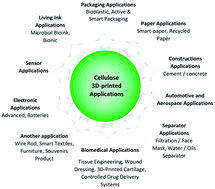3D printed cellulose based product applications
Abstract
As a natural material that is abundant, versatile, and sustainable, cellulose is an alternative that is expected to substitute non-renewable polymers. The physicochemical characteristics of natural cellulose are related to its isolation process that results in cellulose having a particular chain length, crystallinity, and number of inter and intramolecular hydrogen bonds. These characteristics, for particular cellulosic materials, may differ from those of others, providing unique characteristics for cellulose. The study of cellulose as a potential biopolymer for producing environmentally friendly 3D printed products is interesting. Cellulose and its derivatives can be developed as sustainable inks to print products with a desired 3D design quickly and cost-effectively using 3D printing technology. Cellulose ink-based 3D printing technology is expected to support Industry 4.0 for product applications in various fields, such as biomedicine, electronics, building construction, sensors, packaging, paper manufacturing, living bioinks, automotives, aerospace, separators, and various others. This review highlights the many promising and diverse functions and applications of sustainable 3D printed cellulose-based products.



 Please wait while we load your content...
Please wait while we load your content...